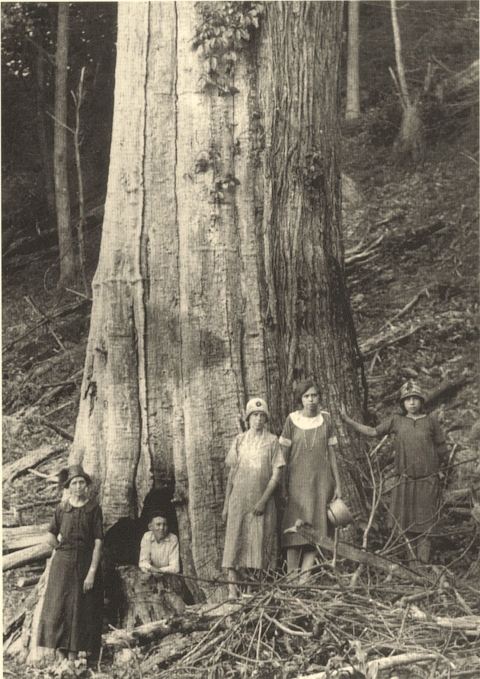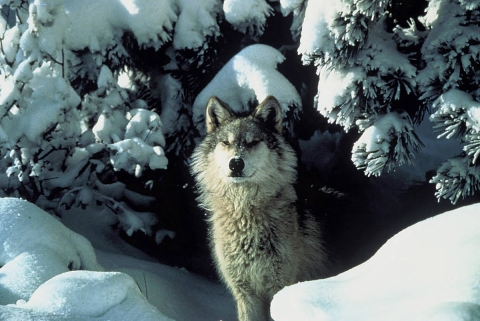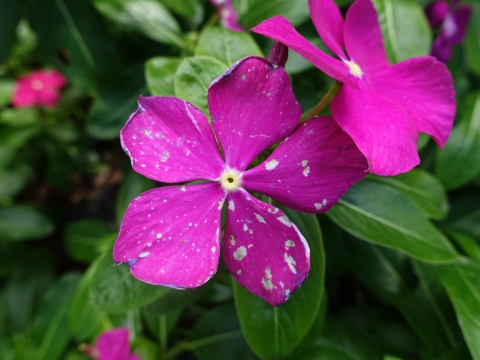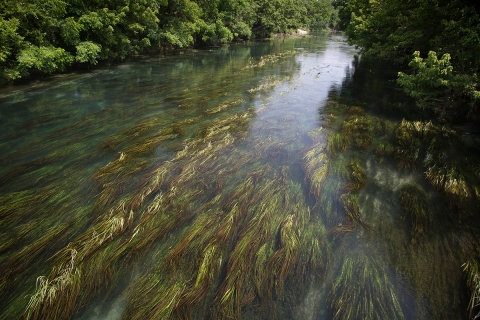Since life began on Earth, countless creatures have come and gone, rendered extinct by naturally changing physical and biological conditions.
Since extinction is part of the natural order, and if many other species remain, some people ask: “Why save endangered species? Why should we spend money and effort to conserve them? How do we benefit?”
Congress answered these questions in the preamble to the Endangered Species Act of 1973, recognizing that endangered and threatened species of wildlife and plants “are of aesthetic, ecological, educational, historical, recreational, and scientific value to the Nation and its people.” In this statement, Congress summarized convincing arguments made by scientists, conservationists, and others who are concerned by the disappearance of unique creatures. Congress further stated its intent that the Act should conserve the ecosystems upon which endangered and threatened species depend.
Although extinctions occur naturally, scientific evidence strongly indicates that the current rate of extinction is much higher than the natural or background rate of the past. The main force driving this higher rate of loss is habitat loss. Over-exploitation of wildlife for commercial purposes, the introduction of harmful exotic (nonnative) organisms, environmental pollution, and the spread of diseases also pose serious threats to our world’s biological heritage.
Conservation actions carried out in the United States under the Endangered Species Act have been successful in preventing extinction for 99 percent of the species that are listed as endangered or threatened. However, species loss on a global scale continues to increase due to the environmental effects of human activities.
Biologists estimate that since the Pilgrims landed at Plymouth Rock in 1620, more than 500 species, subspecies, and varieties of our Nation’s plants and animals have become extinct. The situation in Earth’s most biologically rich ecosystems is even worse. Tropical rainforests around the world, which may contain up to one half of all living species, are losing millions of acres every year. Uncounted species are lost as these habitats are destroyed. In short, there is nothing natural about today’s rate of extinction.
Not too long ago, almost one quarter of the trees in the Appalachian forests were American chestnuts. They helped support not only wildlife but the people living among them. Chestnuts were an important cash crop for many families. As year-end holidays approached, nuts by the railroad car were sold and shipped to northeastern cities. Chestnut timber, strong and rot resistant, was prized for building barns, fences, furniture, and other products.
First detected in 1904, an Asian fungus to which native chestnuts had little resistance appeared in New York City trees. The blight spread quickly, and by 1950 the American chestnut was virtually extinct except for occasional root sprouts that also became infected. Organizations such as the American Chestnut Foundation are working with plant breeders to develop a disease resistant strain and restore it to the eastern forests.
Benefits of Natural Diversity
How many species of plants and animals are there? Although scientists have classified approximately 1.7 million organisms, they recognize that the overwhelming majority have not yet been catalogued. Between 10 and 50 million species may inhabit our planet.
None of these creatures exists in a vacuum. All living things are part of a complex, often delicately balanced network called the biosphere. The earth’s biosphere, in turn, is composed of countless ecosystems, which include plants and animals and their physical environments. No one knows how the extinction of organisms will affect the other members of its ecosystem, but the removal of a single species can set off a chain reaction affecting many others. This is especially true for “keystone” species, whose loss can transform or undermine the ecological processes or fundamentally change the species composition of the wildlife community.
The gray wolf is one such keystone species. When wolves were restored to Yellowstone National Park, they started to control the park’s large population of elk, which had been over consuming the willows, aspen, and other trees that grew along streams. The recovery of these trees is cooling stream flows, which benefits native trout, and increases nesting habitat for migratory birds. Beavers now have willow branches to eat, and beaver dams create marshland habitat for otters, mink, and ducks. Wolves even benefit the threatened grizzly bear, since grizzlies find it easier to take over a wolf kill than to bring down their own elk.
Contributions to Medicine
One of the many tangible benefits of biological diversity has been its contributions to the field of medicine. Each living thing contains a unique reservoir of genetic material that has evolved over eons. This material cannot be retrieved or duplicated if lost. So far, scientists have investigated only a small fraction of the world’s species and have just begun to unravel their chemical secrets to find possible human health benefits to mankind.
No matter how small or obscure a species, it could one day be of direct importance to us all. It was “only” a fungus that gave us penicillin, and certain plants have yielded substances used in drugs to treat heart disease, cancer, and a variety of other illnesses. More than a quarter of all prescriptions written annually in the United States contain chemicals discovered in plants and animals. If these organisms had been destroyed before their unique chemistries were known, their secrets would have died with them.
A few hundred wild species have stocked our pharmacies with antibiotics, anti-cancer agents, pain killers, and blood thinners. The biochemistry of unexamined species is an unfathomed reservoir of new and potentially more effective substances. The reason is found in the principles of evolutionary biology. Caught in an endless “arms race” with other forms of life, these species have devised myriad ways to combat microbes and cancer-causing runaway cells. Plants and animals can make strange molecules that may never occur to a chemist. For example, the anti-cancer compound taxol, originally extracted from the bark of the Pacific yew tree, is “too fiendishly complex” a chemical structure for researchers to have invented on their own, said a scientist with the U.S. National Cancer Institute. Taxol has become the standard treatment for advanced cases of ovarian cancer, which strikes thousands of women every year. But until the discovery of taxol’s effectiveness, the Pacific yew was considered a weed tree of no value and was routinely destroyed during logging operations.
Some of the most promising natural wonder drugs come from compounds not usually associated with healing: poisons. One pharmaceutical company is marketing a blood thinner based on the venom of the deadly saw-scaled viper. A protein from another Asian pit viper is being studied because it appears to inhibit the spread of melanoma cells, and a compound from the venom of some tarantula species may lead to new treatments for neurological disorders such as Parkinson’s disease.
Biodiversity and Agriculture
Many seemingly insignificant forms of life are beginning to show important benefits for agriculture. Farmers are using insects and other animals that prey on certain crop pests, as well as using plants containing natural-toxins that repel harmful insects. These are called “biological controls,” and in many cases they are a safe, effective, and less expensive alternative to synthetic chemicals.
Thomas Jefferson once wrote that “the greatest service which can be rendered any country is to add a useful plant to its culture, especially a breadgrain.” It has been estimated that there are almost 80,000 species of edible plants, of which fewer than 20 produce 90 percent of the world’s food. If underutilized species are conserved, they could help to feed growing populations. One grain native to the Great Lakes States, Indian wild rice, is superior in protein to most domesticated rice, and its increasing commercial production earns millions of dollars annually. Crossing it with a related but endangered species, Texas wild rice, could result in a strain adaptable to other regions of the country.
Environmental Monitors
Many individual species are uniquely important as indicators of environmental quality. The rapid decline in bald eagles and peregrine falcons in the mid-20th century was a dramatic warning of the dangers of DDT—a strong, once widely used pesticide that accumulates in body tissues. (It hampered fertility and egghatching success in these species.) In another example, lichens and certain plants like the eastern white pine are good indicators of excess ozone, sulfur dioxide, and other air pollutants. Species like these can alert us to the effects of some contaminants before more damage is done.
Freshwater mussels are also very effective environmental indicators. The eastern United States boasts the richest diversity of freshwater mussels in the world. These animals are filter feeders, drawing in water and straining out food particles. Their method of feeding helps to keep our waters clean. But because mussels filter material from the water, they are often the first animals to be affected by water pollution. They tend to accumulate whatever toxins, such as chemicals in agricultural and industrial runoff, are present in their habitat. Too much pollution can eliminate the mussels. Other threats to mussel populations include siltation, the introduction of competing nonnative mussels, stream channelization and dredging, and the impoundment of free-flowing streams and rivers. Today, most native freshwater mussel species are considered to be endangered, threatened, or of special concern.
Ecosystem Services
One example of an ecosystem service not widely known is that plants remove, transfer, stabilize, and destroy contaminants in soil and sediment. Certain plant species have the ability to extract elements from the soil and concentrate them in the easily harvested plant stems, shoots, and leaves. The alpine pennycress, for example, doesn’t just thrive on soils contaminated with zinc and cadmium; it cleans them by removing the excess metals. In the home, houseplants under some conditions can effectively remove benzene, formaldehyde, and certain other pollutants from the air.
Other Economic Values
Some benefits of animals and plants can be quantified. For example, the International Fund for Animal Welfare named whale watching one of the fastest growing tourism products in the world. In 2009, 13 million whale watchers from 119 countries pumped an estimated $2 billion into the global economy. The U.S. is home to a great diversity of plants and animals, and opportunities for experiencing unique species in nature abound. In a recent survey (Wildlife Watching in the United States: The Economic Impacts on National and State Economies), the U.S. Fish and Wildlife Service found that wildlife watching— not limited to whales—generated $55 billion in economic benefits to the nation in 2011.
Intangible Values
If imperiled plants and animals lack a known benefit to mankind, should we care if they disappear? If a species evolves over millennia or is created by divine intent, do we have a right to cause its extinction? Would our descendants forgive us for exterminating a unique form of life? Such questions are not exclusive to scientists or philosophers. Many people believe that every creature has an intrinsic value. The loss of plant and animal species, they say, is not only shortsighted but wrong, especially since an extinct species can never be replaced. Eliminating entire species has been compared to ripping pages out of books that have not yet been read. We are accustomed to a rich diversity in nature. This diversity has provided inspiration for countless writers and artists, and all others who treasure variety in the natural world.









